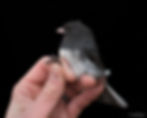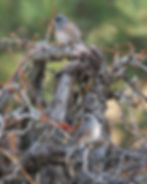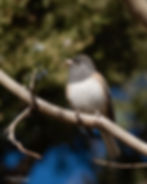Snowbirds: A Guide to Identification and Appreciation
- mitchellpruitt
- Feb 17, 2021
- 11 min read
As an early American ornithologist put it, “there is not an individual in the Union who does not know the little Snow-bird” (Audubon 1831). In my experience, this holds true today. The Dark-eyed Junco (Junco hyemalis), colloquially known as snowbird, is easily recognized across the continent: small, sharply contrasting plumage, pink bill (for the most part), and winters widely across North America—hence “snowbird”. They’re equally as common at bird feeders as in the middle of the forest. In winter, you’ll rarely see juncos alone, but in flocks small and large; from a handful up to several hundred. You might also find them associated with the ground-level portion of a mixed feeding flock, often among other sparrows.
While the Dark-eyed Junco as a whole may be easily recognized, many individuals leave birders scratching their heads, unable to pinpoint exactly what they saw. What we know as Dark-eyed Junco actually encompasses 15 different subspecies—historically there were even more, but several have obtained full species status, some of them questionably so. Until the 1970s, five of the major subspecies groups recognized today were considered separate species (Nolan et al. 2020). If you think we have it bad now with all the subspecies, imagine needing to care enough to pick them apart for your life list. It’s no surprise that juncos are one of the biggest avian taxonomical nightmares in North America and perhaps the world. Many birders don’t care about subspecies, but I hope to change your mind.

Yellow-eyed Junco, Chiricahua Mountains, AZ. The only other full species of junco in the U.S. has its own troublesome set of relatives, most of which occur down the Sierra Madres into Central America.
Doing much more than glancing at a junco causes the eyes of many birders to roll back in their heads. This is particularly the case for those living between the Rocky Mountains and Mississippi River, where subspecies diversity is quite high in wintering populations. But if you remain calm, this blog and other resources—maybe a therapist—might be able to help you through.
A Brief Introduction to the Main Characters
The Slate-colored Junco, also known as the Hyemalis Group, encompasses three distinct subspecies. They include J. h. carolinensis, which I’ll leave out as it rarely wanders from its year-round range in the Appalachians, and J. h. cismontanus, which I’ll come back to later. This leaves us with J. h. hyemalis, the classic “eastern” junco that breeds across our boreal regions and winters mostly east of the Rocky Mountains (Nolan et al. 2020).

Slate-colored Junco (J. h. hyemalis), Benton County, AR. An adult male captured and ready for banding by permitted researchers.
The Oregon Junco, also known as the Oreganus Group, encompasses a shocking eight subspecies, many of which aren’t important for a birder living between the Mississippi and the Rockies. Details among them are often so minute that most subspecies within this group are typically referred to as J. h. oreganus, though the true J. h. oreganus are quite limited in range along the northwest coasts. Regardless, members of this group breed across western North America, from the Pacific and over the Rockies. They winter across a similar range, including the Great Plains, where “Oregon” Juncos are common. Though, what birders in this region are likely to see are probably J. h. montanus. The latter is less range-restricted than true J. h. oreganus and is found down the Rockies (Nolan et al. 2020).

Oregon Junco (J. h. [oreganus group]), Davis Mountains, TX. A striking "Oregon" female, probably J. h. montanus.
The Pink-sided Junco (J. h. mearnsi), is technically part of the Oreganus Group, but is distinct and often considered separate. This subspecies breeds largely around the Teton Range and Yellowstone Plateau, but winters much more widely down the Rockies and, like some other members of the Oreganus Group, limitedly east across the Great Plains (Nolan et al. 2020).

Pink-sided Juncos (J. h. mearnsi), Fort Collins, CO. Not an award-winning photo, but a duo of Pink-sideds nonetheless.
Now I’ll come back to J. h. cismontanus. Latin cismontane means “on this side of the mountains”, which, to the ornithologist who suggested the name, was referring to the east side of the Rockies (Dwight 1918). I should also note that this species apparently has a common name that is not widely used, but dates back to the early 20th-century: Cassiar Junco (Warren 1923). I’m sure there’s a good, taxonomical reason for including this one in the Hyemalis Group today, but it has some plumage characteristics that set it apart. This subspecies breeds in the boreal regions of northwestern North America and winters from the Pacific Coast, east to the Mississippi River, occasionally wandering as far as the East Coast.

Cassiar Junco (J. h. cismontanus), Washington County, AR. Very Slate-colored-looking from the front, but it's the same bird in another photo below, looking completely different from the side!
The Gray-headed Junco, also known as the Caniceps Group, encompasses two subspecies. J. h. dorsalis is limited to the sky island ranges of the desert southwest and, therefore isn’t a player in our region. The other one, J. h. caniceps, breeds widely down the Rockies and winters in lower elevations, with some populations that stretch out across the Great Plains. I’m not sure why, but this subspecies seems not to stray often into our region, or is just underreported.
One thing I should mention is that most of these subspecies groups have breeding range overlaps somewhere on the continent, sometimes significantly so. This means you’re likely to encounter individuals that are hybrids formed by any number of pair options. Hybrids of nearly any Dark-eyed Junco subspecies are considered viable, which is one of the reasons they are not currently considered separate species; their genetics are just too muddied. I’ve always hated math, so I’ll let the reader determine how many possible junco hybrid combinations there are in North America. If you encounter a junco that doesn’t seem to fit into any of the boxes—and there are a lot of them—feel free to attempt to determine its parentage, but it might be best for your mental health if you just leave it as Junco hyemalis ssp. and walk away.
A Junco Dichotomous Key
Now that you’ve had a brief introduction and a warning, let’s get started with a quick and dirty “dichotomous key” to the juncos of “Middle America”: the land between the great river and high mountains. If you live from the Rockies west, sorry, your life is probably much harder! If you live east of the Mississippi, your life may be much easier. Key based on Neal 2003, Beadle & Rising 2008, Peterson 2019, Nolan et al. 2020; though I recently discovered a new North American sparrow guide that seems worthwhile (Wright 2019).
1-Does the junco in question have a grayish hood that begins with a contrast in color between the neck and back, and extends into a convex bib on the breast? The hood can either be well-defined or faint.
1a-If yes, you may have an interesting “western” junco! Continue to 2.
1b-If no, and your junco has no hood and either a concave bib or no bib at all, continue to 4.
2-Does the junco in question have well-defined, gray hood and bib that are very easy to see, or does it have faint hood and bib that could be difficult to discern?
2a-If well-defined, grayish hood and bib are present, then you may have an Oregon (Junco hyemalis oregani) or Pink-sided (Junco hyemalis mearnsi) Junco! Continue to 3.
2b-If a hood and bib are present, but seem to blend into the back and flanks, respectively, then you may have a Cassiar Junco (Junco hyemalis cismontanus)! See “Digging Deeper” below.
3-Does the junco in question have a narrow strip of pinkish-buff on the sides, leaving white underparts well exposed; OR does the junco have a thick strip of pinkish-buff on the sides, extending onto the breast and belly?
3a-If a narrow strip, you may have an Oregon Junco. See “Digging Deeper” below.
3b-If a thick strip extending onto white underparts, you may have a Pink-sided Junco. See “Digging Deeper” below.
4-Does the junco in question have a well-defined line between white underparts and uniform slaty upperparts, or is the junco light gray all over with a striking rufous patch on the back?
4a-If the junco is uniformly slate-gray with a well-defined line between dark upperparts and white underparts, you’re probably looking at a Slate-colored Junco (Junco hyemalis hyemalis)! See “Digging Deeper” below.
4b-If the junco is light gray with little to no contrast between upper- and underparts AND has an obvious rufous patch on the back, then you’re probably looking at a Gray-headed Junco (Junco hyemalis caniceps)! See “Digging Deeper” below.
Digging Deeper
Oregon Junco
The Oregon Junco in our region, likely J. h. montanus, is quite striking. Males have VERY well-defined divisions between a dark gray hood, narrow buffy flanks, and brownish back; rendering them almost reminiscent of Eastern Towhee color patterns. Females have lighter gray hoods and are more drab overall, but with the same noticeable color scheme. In both sexes, there are no well-defined dark lores as in Pink-sided Juncos and buffy flanks are restricted, leaving white underparts…well…white. Some individuals may retain juvenile plumage through winter, resulting in a bird that is female-looking overall, with perhaps some less well-defined margins between hood, back, and flanks (Neal 2003, Beadle & Rising 2008, Peterson 2019, Nolan et al. 2020).

Oregon Junco (J. h. [oreganus group]), Salt Lake City, UT. An "Oregon" male (?), probably J. h. montanus.

Oregon Junco (J. h. [oreganus group]), Washington County, AR. An "Oregon"-esque Junco, perhaps a juvenile female of J. h. montanus.

Oregon Junco (J. h. [oreganus group]), Washington County, AR. I've spent a lot of time staring at this bird and going back and forth. I believe it to be a female of the Oreganus Group, probably J. h. montanus. Tough isn't it?
Pink-sided Junco
Pink-sided Juncos (J. h. mearnsi) are distinct in plumage characteristics from typical Oregon juncos, but are still technically part of the Oreganus Group. A sharp male Pink-sided Junco has a pearly-gray hood and bib, buffy sides extending onto white underparts, and distinctive lores that are darker than the surrounding plumage. The female Pink-sided is similar, but with dark lores that may not be as noticeable. Some individuals may retain juvenile plumage through winter, resulting in a bird that is female-looking overall, with perhaps some less well-defined margins between hood, back, and flanks (Neal 2003, Beadle & Rising 2008, Peterson 2019, Nolan et al. 2020). See photo used in introduction above.
Slate-colored Junco
The Slate-colored Junco in our region, J. h. hyemalis, is what most birders I know picture when they think of a junco, though admittedly the stereotype is probably different for westerners. Males have slate gray upperparts so dark as to be nearly black, with no hooded appearance and a bib ranging from straight to concave, resulting in a stark line of contrast between upper and underparts. Flanks are grayish. Female Slate-coloreds can be problematic. While a typical female is usually a paler gray version of what I just described, they and juveniles can have some brown on the back and flanks. This shouldn’t be too extensive, though. If it is, then you might have a Cassiar Junco (Neal 2003, Beadle & Rising 2008, Peterson 2019, Nolan et al. 2020).

Slate-colored Junco (J. h. hyemalis), Washington County, AR. A sleek male showcasing stark division between slate gray and white, and a concave bib.

Slate-colored Junco (J. h. hyemalis), Washington County, AR. A light gray female with stark division between upper- and underparts, and a concave bib. This individual also has a little brown to spice things up.
Cassiar Junco
Cassiar Juncos (J. h. cismontanus) are part of the Hyemalis Group, but distinct in plumage characteristics from other Slate-coloreds. Cassiar Juncos have a hood that is often faint, but should contrast to a lesser (sometimes greater) extent with the back. The bib should be convex and may contrast with flanks for a more Oreganus experience, but not necessarily. Flanks of the Cassiar Junco can range from buffy to gray, to a combination of both. Overall, the bird may appear light gray, more like a female Slate-colored, but with a lot of buffy brown coloration that seems out of place on the back, head, and even stippling the bib. Cassiar doesn’t fit well into either of the Hyemalis or Oreganus boxes. In fact, this subspecies may have come from hybrids of these two groups that formed a stable population. They’re basically the best of both worlds, making for one of the worst identification challenges.

Cassiar Junco (J. h. cismontanus), Washington County, AR. The same slate-colored-looking individual from above. From this angle you can see the faint hood and convex bib that contrasts with the flanks.

Cassiar Junco (J. h. cismontanus), Washington County, AR. This individual is from the "Oregon" end of the spectrum, with more buff and brown, but still faintly hooded, with a convex bib that blends well into flanks.
Gray-headed Junco
The Gray-headed Junco in our region, J. h. caniceps, is a real wild card. This subspecies is less sexually dimorphic and, overall, should be a uniform light gray above and below, with striking dark lores, and a defined ruddy triangle on the back. There aren’t many records in the east, but we do have a few in Arkansas!
Other major North American subspecies that don’t appear in this text are the White-winged Junco (J. h. aikeni) and endangered Guadalupe Junco (J. insularis), which has recently obtained species status. Congrats to J. insularis for leaving its familial issues behind! If you’re ever in the Black Hills, or an isolated island off Baja, you should definitely check them out.
Though it would be interesting to have more accurate data showing what subspecies occur where, particularly in winter, there’s no shame in simply walking away and calling a junco a junco. On a similar note, if you see a flock of what you know are juncos, try not to report that they were all your locally common subspecies, just because they likely were. In reality, there was probably someone among that flock that was different! I’m also guilty of this. There’s no shame in simply reporting Dark-eyed Junco, rather than identifying it further, especially if you had a fleeting glimpse, or didn't get photos. They are all a single species at the end of the day, but I do encourage you to take a closer look and not leave that statement as your answer to life’s junco problems. After all, there’s a reason so many junco subspecies diverged so distinctively, even if our scientific community has yet to identify that reason. It could be as simple as what plumage blended best within a certain habitat, but there could be something much more interesting at work!
Some Parting Tips for the Field
1) If you live between the Mississippi and the Rockies, and you meet a confusing junco, you may need to look no further than our friend Cassiar. If Cassiar doesn’t cut it, and neither do any of the more well-defined subspecies, then you likely have a hybrid. Hybrids coming from card-carrying purebred parents of two distinct subspecies are often easily recognizable, but hybridization is common in juncos and you’re likely to see one that has been crossed multiple times across its genetic history, resulting in an unidentifiable Little Brown Job; or maybe a Little Gray Job.
2) Photography is key. Juncos often seem loathe to sit still long. If you can get a photo of a strange looking junco, your chance of cracking its code is greater.
3) Resources for easily identifying junco subspecies are slim. Probably because it can quickly become an overbearing task. However, the data is there. Look no further than the Cornell Lab of Ornithology’s Macaulay Library. They curate a vast collection of photos online that can be easily sorted. Check out links to some of the junco subspecies mentioned in this story below. I’m no expert in junco identification, but there are some obvious mistakes that have slipped through the cracks here, so just be cautious as you click through photos.
Macaulay Library Links
Slate-colored Junco: https://search.macaulaylibrary.org/catalog?taxonCode=slcjun&q=Dark-eyed%20Junco%20(Slate-colored)%20-%20Junco%20hyemalis%20hyemalis/carolinensis
Pink-sided Junco: https://search.macaulaylibrary.org/catalog?taxonCode=pisjun&q=Dark-eyed%20Junco%20(Pink-sided)%20-%20Junco%20hyemalis%20mearnsi
Cassiar Junco: https://search.macaulaylibrary.org/catalog?taxonCode=daejun1&q=Dark-eyed%20Junco%20(cismontanus)%20-%20Junco%20hyemalis%20cismontanus
Gray-headed Junco: https://search.macaulaylibrary.org/catalog?taxonCode=gyhjun&q=Dark-eyed%20Junco%20(Gray-headed)%20-%20Junco%20hyemalis%20caniceps
Literature Cited
Audubon, J. J. 1831. Ornithological biography. Vol. 1. Edinburgh: J. J. Audubon.
Beadle, D. R. and J. D. Rising. 2001. Sparrows of the United States and Canada: The Photographic Guide. Princeton University Press.
Dwight, J. 1918. The geographic distribution of color and of other variable characters in the genus Junco: a new aspect of specific and subspecific values. Bulletin of the American Museum of Natural History 38:269-309.
Neal, J. C. April 2003. The Junco Challenge: A Genuine Pink-sided Junco from Arkansas and Some Look-alikes. Birding Magazine. American Birding Association.
Nolan Jr., V., E. D. Ketterson, D. A. Cristol, C. M. Rogers, E. D. Clotfelter, R. C. Titus, S. J. Schoech, and E. Snajdr. 2020. Dark-eyed Junco (Junco hyemalis), version 1.0. In Birds of the World (A. F. Poole and F. B. Gill, Editors). Cornell Lab of Ornithology, Ithaca, NY, USA. https://doi.org/10.2173/bow.daejun.01
Peterson, R. T. 2019. Field Guide to Birds of North America, 2nd Edition. Houghton Mifflin Harcourt.
Warren, E. R. 1923. Concerning the Cassiar Junco. Condor 25:27-28.